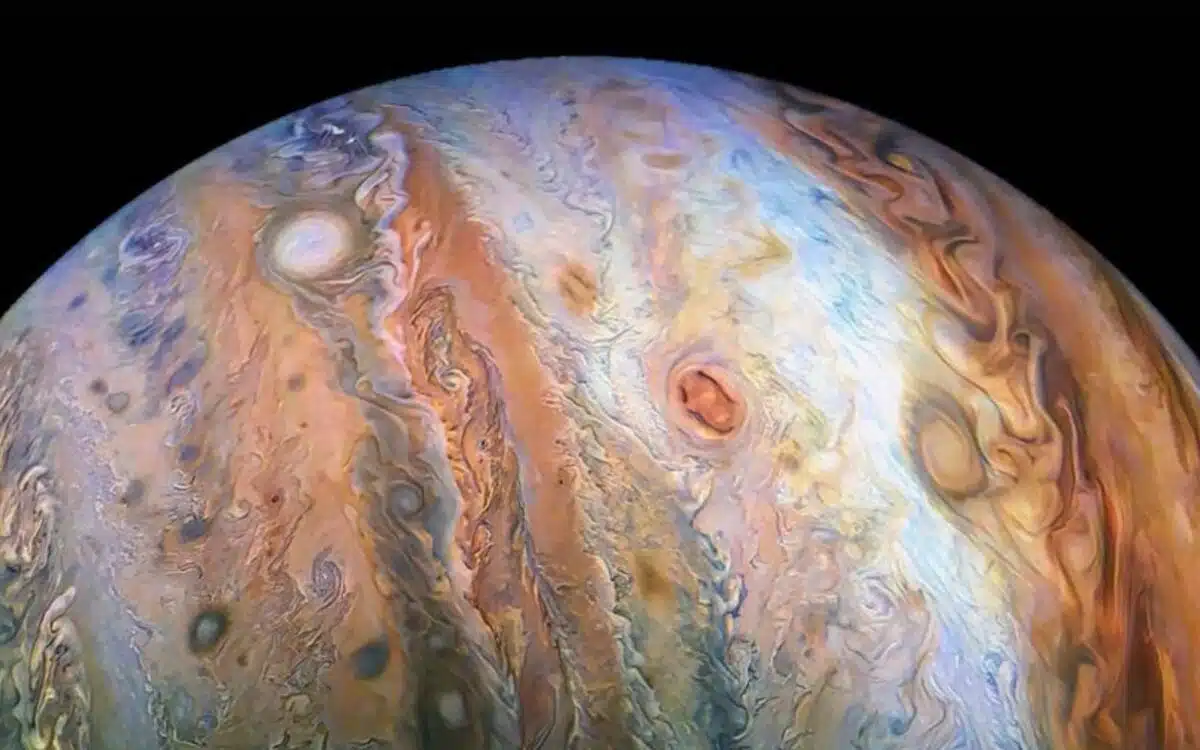
Arezki Amiri Published on November 8, 2024
Collected at: https://dailygalaxy.com/2024/11/jupiter-doesnt-have-a-surface-to-land-on/
Jupiter, the massive planet that dominates our solar system, offers a mind-bending concept: it has no solid surface. Unlike Earth, with its solid crust, rocks, and mountains, Jupiter is a swirling, dynamic gas giant without any place to stand or land. How does such a planet hold together, and what lies beneath its endlessly turbulent atmosphere?
The Structure of Jupiter: No Solid Ground
Jupiter, located between Mars and Saturn, is the fifth planet from the sun and the largest in our solar system. Its sheer size is staggering; over a thousand Earths could fit inside it. Yet, unlike the rocky inner planets (Mercury, Venus, Earth, and Mars), Jupiter is composed primarily of hydrogen and helium, similar to the makeup of the sun.
It’s a vast, violent expanse of gases with winds that reach speeds of over 400 miles per hour (643.74 km/h)—three times faster than a Category 5 hurricane on Earth.
As you descend into Jupiter’s atmosphere, pressure increases exponentially, creating conditions unlike anything experienced on Earth. Unlike Earth’s surface, which is solid and supports life, Jupiter’s atmosphere transitions into bizarre states of matter due to the intense pressure and temperature changes as you go deeper.

An Ocean Without Water
On Earth, going down through the atmosphere eventually brings you to solid ground, either land or water. But on Jupiter, things get strange. Beginning near the top of its gaseous envelope, the atmospheric pressure intensifies the deeper you go, reaching levels that would crush the human body.
Approximately 1,000 miles (1,609.34 km) below the upper layers, the gas thickens into a strange, dense liquid hydrogen. Think of this as Jupiter’s ocean, but an ocean without water—one made of liquid hydrogen. This fluid environment is denser than anything found on Earth, creating an immense, planetary-scale “sea” within Jupiter’s layers.
Going further down, around 20,000 miles (32,186.88 km) deep, the hydrogen behaves even more extraordinarily. It transforms into liquid metallic hydrogen, a highly exotic form of matter that can conduct electricity. This form of hydrogen is so extreme that scientists have only recently managed to replicate it in labs. But it’s not a clear boundary; the transition between gas, liquid, and metallic forms of hydrogen happens smoothly over layers, without any solid surface.
An Unearthly Environment to the Core
As you approach Jupiter’s core, you won’t encounter a solid center. The core itself remains a mystery, with theories suggesting it might be a dense, hot mixture of rock, metallic hydrogen, and possibly other elements in a superheated, partially molten state.
Pressures here are mind-blowing—equivalent to about 100 million times Earth’s atmospheric pressure. Any spacecraft that ventured here would be destroyed by crushing pressure and temperatures that soar to 35,000 degrees Fahrenheit (19,426.67 °C), making Jupiter’s core hotter than the surface of the sun.
This extreme core region may hold clues about Jupiter’s formation, yet it’s entirely inhospitable to exploration due to the extraordinary conditions.

Jupiter’s Protective Role for Earth
Despite its harshness, Jupiter plays a critical role in the stability of our solar system—and potentially in our existence. With its enormous gravitational pull, Jupiter has been a cosmic shield for the inner planets, deflecting or altering the paths of asteroids and comets that might otherwise collide with Earth. By absorbing or redirecting these dangerous objects, Jupiter has helped to reduce the likelihood of catastrophic impacts, similar to the one that may have wiped out the dinosaurs.
In essence, Jupiter’s massive presence in our solar system has acted as a protective barrier, which could be one reason life was able to flourish on Earth.
Looking Beyond Jupiter: Europa
While Jupiter itself is inhospitable, one of its moons, Europa, presents an intriguing possibility for life beyond Earth. Europa is thought to harbor a vast, subsurface ocean beneath its icy crust—a water-rich environment that could potentially support microbial or even more complex life forms.
NASA’s Europa Clipper mission, launched in October 2024, will conduct detailed flybys of this moon, investigating its icy surface and searching for clues of life within its underground ocean.
However, the mission is a long one; due to the distance, the spacecraft isn’t expected to reach Europa until 2030. If any signs of life are found, it could mark a groundbreaking discovery in our search for extraterrestrial life.

Leave a Reply